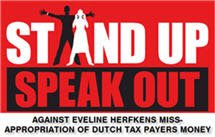CLICK HERE FOR STORY AT NEWJERSEYNEWSROOM
BY ROY NERSESIANCOMMENTARY
It could be worse — lower carbon emissions would result in even colder weather!
Global warming is a hot topic and it's heating up. After the Healthcare Bill is resolved one way or the other, the next agenda item is cap and trade, which by any measure will be costly to Americans and will make Al Gore a billionaire from his investments in cap and trade providers.
The following temperature chart shows that average temperatures in the United States have increased from 52 degrees Fahrenheit in 1895 to 53.5 degrees in 2009, an impressive 1.5 degree increase.
GRAPH NO. 1

Global warming alarmists link this phenomenon to the following chart. (The reference to the Pinatubo volcano is that its eruption pumped a great deal of sulfur dioxide into the atmosphere covering tops of clouds with an aerosol that reflected sunlight. This reduced the amount of sunlight reaching the earth, cooled the oceans that allowed greater carbon dioxide absorption temporarily reducing its concentration in the atmosphere.)
GRAPH NO. 2

Global warming alarmists link the two curves insisting that there is a causal relationship between the rising carbon dioxide content in the atmosphere and global temperatures. Well, if there is a direct causal relationship, how does one explain the general cooling trend from 1940 to 1970? And what about the cooling trend starting around 2000? This one I'll answer — "it's a short term cooling trend contained within a long term warming trend", which, by the way, could be true. But it's not obvious that it's true.
Perhaps the greatest criticism against the global warming alarmists is their myopic concentration on a single variable model. There are other global warming gases - methane is one that is also increasing. The most important gas in the atmosphere that affects global temperatures is not carbon dioxide or methane, but water vapor and degree of cloud cover. But little is mentioned of these because of a lack of historical data.
Global warming alarmists never speak of the precession of the earth about its axis, which is closely tied to past ice ages, nor do they speak about variation in the energy emitted by the sun and its impact on climate. The Medieval Warming period from 1100 to 1250 where temperatures rose to the point where coastal Greenland was actually green and fit for settlement corresponded to a period of high sunspot activity. The subsequent Little Ice Age that forced the abandonment of Greenland was marked by an exceptional period of cold weather known as the Maunder Minimum from 1645 to 1715 when sunspot activity was nil. The Dalton Minimum that lasted several decades from 1790 has been deemed responsible for the extremely cold winter that wiped out Napoleon's army during its 1812 retreat from Moscow. The difference between minimum and maximum sunspot activity is only about 0.5% in solar energy emission, but this is enough to disturb the delicate balance of factors affecting the earth's climate.
The following chart shows sunspot activity since 1996 — could the fall in sunspot activity since 2001 be blamed for what appears to be global cooling or even presage the start of another ice age (a view prevalent in the 1970s and beginning to reemerge)?
GRAPH NO. 3

Roy Nersesian, a resident of Maplewood, teaches at the Leon Hess School of Business at Monmouth University in West Long Branch and also at the Center for Energy and Marine Transportation at Columbia University. He has authored several books, the last on Energy for the 21st Century published by M.E. Sharpe.

















































No comments:
Post a Comment